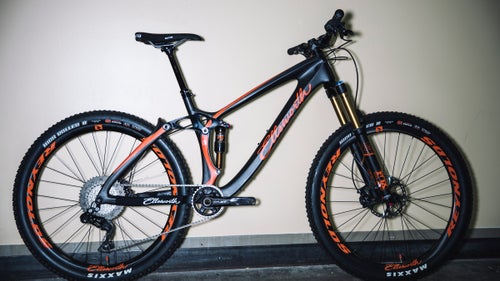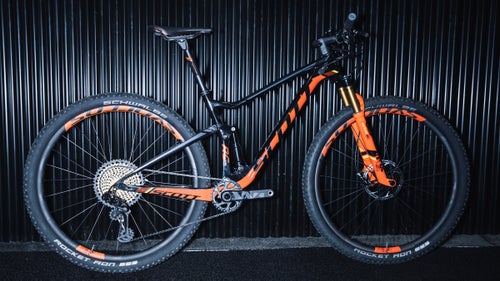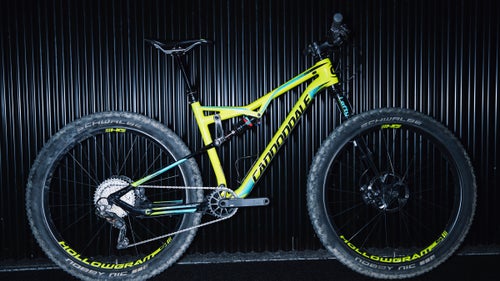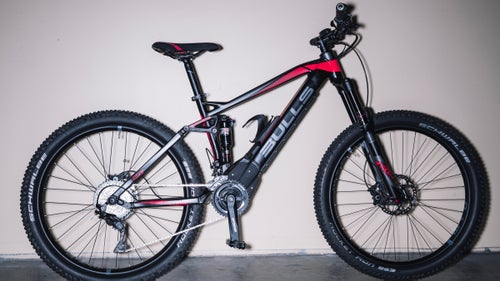The 6 Hottest Mountain Bikes of 2017

From a featherlight race 29er to a fattie that pedals like a normal steed, these were some of the coolest and most promising new rides we saw at Interbike. Just starting out? Learn everything you need to know about buying your first mountain bike.
Photo: Otso Voytek
Otso is a new bike brand from the same folks behind Wolf Tooth Components, and their two new bikes, including the , are as clever and well-conceived as their small parts. Otso engineer and brand manager Brendan Moore calls it a “plus bike that fits fat,” because the carbon frame can be equipped to accommodate both 27.5+ and 29+ wheels, as well as 26ers with up to 4.6 rubber. The versatility comes courtesy of a proprietary, three-way flip chip at the rear dropouts, which not only allows the wheel swaps but also makes it possible to change the rear chain stay length (between 430mm and 450mm in ten millimeter increments), thereby changing the bike’s entire feel and handling. The Voytek also has the narrowest Q-factor of any fat bike out there (thanks to a special Wolf Tooth chain ring), which will make it ride more like a standard hard tail than a fatty. It’s the bike I’ve been wanting for years because, at last, your year-round rig can double as a winter fattie without compromise in either format. Complete bikes start at $3,900.

After stalling out for the last couple of years, this San Diego, California-based manufacturer appears to have returned to the forefront with a new, fully modern bike design. The promises to keep Ellsworth’s excellent pedaling performance, thanks to a new iteration of (and acronym for) its longstanding instant center tracking suspension. It also trades the last few years’ steep head angles and long stem lengths for a low, long, slack geometry. If it climbs like Ellsworth’s of old, this 140mm trail bike, complete with hyper-short chain stays for snappy acceleration and handling, Boost hub spacing, wide bars, and dropper seat post, may just be the sleeper bike of the year. There’s even a seriously rowdy 160mm spec built around the same frame. It’s still a premium bike, with complete models starting at $4,995.

Okay, first off, is inarguably the best name ever for a plus- or fat-size full-suspension bike. But even before I knew the name, back when I saw the prototype and marketing materials last year, it was probably the model that most excited me. This 100mm alloy frame can fit four-inch tires on either 26- or 27.5-inch rims (or standard-size 27.5+ wheels) and accommodates anything from a 140mm to 180mm fork. It’s true that there are several good full-suspension fat bikes on the market already, including the excellent , but the Lenz bikes I’ve ridden have been exceptional climbers, which should be a welcome change for ordinarily piggy fat bikes. And that big front end should make for some seriously raucous descending capabilities. I also love that the Fattilac will be available in a 29-plus build (with a RockShox RS-1 fork), which might be the only such model out there. Big wheels plus big suspension should equal even bigger fun. The frame is $2,600, but that also includes a Cane Creek DB inline rear shock.

One of the most interesting developments at the show was Scott’s departure from its longtime top-tube–mounted shock design on its full-suspension models to a vertically oriented, single-pivot rocker link design. Not only that, but they did it on their World Championship-winning XC Spark models, yet still managed to keep an incredibly lightweight version, this ($10,000), which they claim tips the scales in the 21-pound range. The new shock configuration is said to provide a more supple top end to the travel and a plusher bottom end. At the same time, in addition to the racing-oriented, 29er-specific SL, Scott will now offer a slacker, trail-oriented Spark configuration with 120mm of travel (in both 27.5 and 29), as well as a 120mm 27.5+-size Spark (with 130mm fork). As if to answer the question of whether the new shock setup is as good as the old, Nino Schurter won the Olympics on this revamped Spark.

If there’s an exemplar of today’s fastest-growing model type in the MTB business, it’s the , a 120mm, somewhat slack (68-degree head tube) trail bike built around 27.5+ tires. Cannondale looks to have done it right, with a 1×11-specific drivetrain configuration, plenty of tire clearance for bigger rubber, and a proprietary hub spacing that’s even wider than Boost. I also love the company’s proprietary Hollowgram crank and single-sided lefty fork, both of which should save big weight—the bane of many plus-size models. Not only that, but it’s one of the best-looking plus-bikes I’ve seen yet. The Bad Habit Carbon 1 goes for $7,500, with one additional carbon model at $4,800 and two alloy models down to $2,600.

Laugh or cry or cringe if you want, but e-MTBs seem to be a lasting trend judging by the huge numbers of them scattered across Interbike’s floor. (Incidentally, e-bikes in general seemed to occupy more of the show’s real estate than ever.) Unlike so many exorbitant models out there, this Bulls doesn’t cost much more than a standard high-quality MTB ($4,900), yet it’s equipped with some of the market’s finest parts, including RockShox fork and shock, Shimano XT drivetrain and hydraulic brakes, and cockpit bits from Ergon. The bike runs on the new Brose motor system, which is said to be smoother, quieter, and more evenly torqued than other models. It won’t be everyone’s cup of tea, but I’m happy to see e-bike prices start to drop while quality continues to improve.